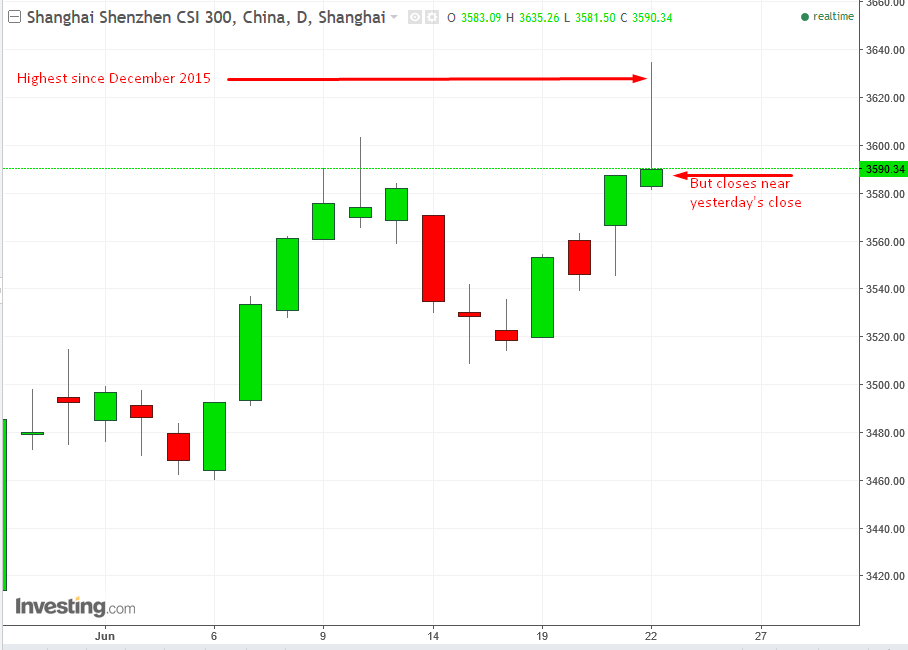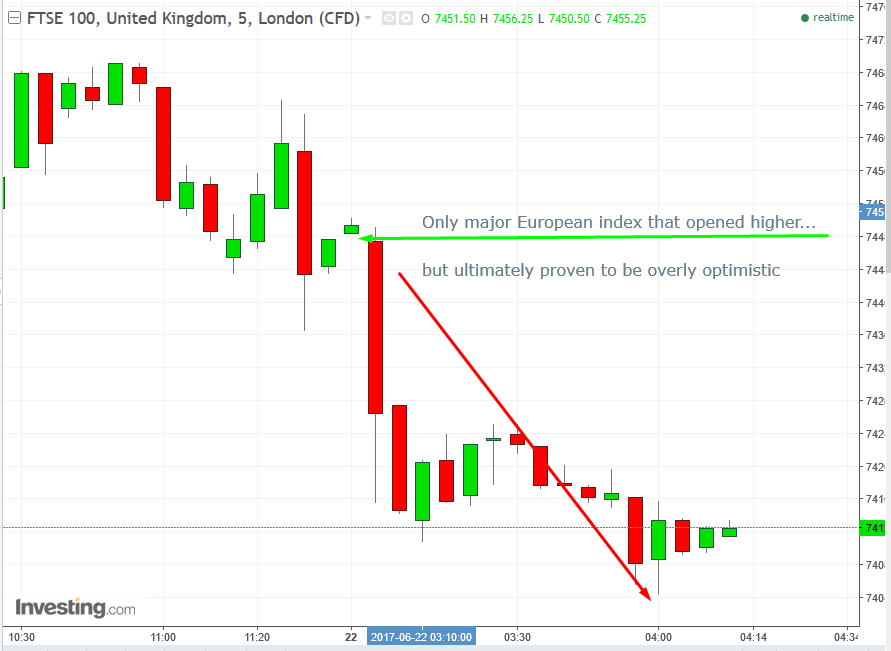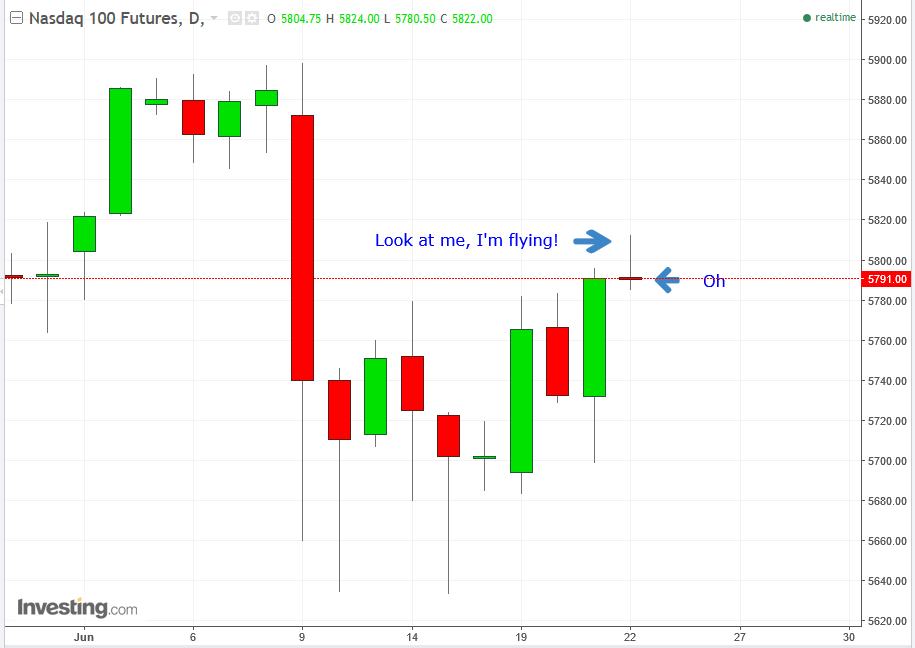by Pinchas Cohen
Key Events
- US futures temporarily climb but flatten out
- Oil struggles in bear market
- Australian equities make comeback after biggest decline since November
- 300 top Chinese stocks reached their highest since December 2015, then retreated
Global Affairs
Safe-havens are back in favor as the yen climbed, gold rose for a second day and bonds were junkier as yields fall. Additionally oil slips further as it faces a bear market.
Nevertheless, Asian stocks managed to climb, led by Australia’s rebound, after its worst fall since President Donald Trump's election victory—when uncertainty of what would happen in the markets was high—on November 9th, the tech sector's recovery after last week's sell-off, and Chinese stocks extending their gains.
The market narrative on WTI is that the rising US output—with no end in sight—will undermine any OPEC/NOPEC cuts in their attempt to stabilize oil's price and return the supply-demand dynamic into balance.
Are China’s mainland shares now safer for investors?

Chinese shares advanced for a second day, after MSCI decided to include domestic equities in its indexes for the first time, after three previous rejections.
While the Financial Times View asserts that “China’s stock market is given a test, not a pass,” in which the country will have to convince the world that it’s serious about having a free market, others view it as a nod of approval and a symbolic gesture of what’s to come. Investors can’t seem to make up their minds about which argument to buy, as the CSI 300, the top 300 stocks traded on both the Shanghai and Shenzhen exchanges, rose up 0.5% to its highest level since December 2015, but has since been fluctuating below and above yesterday’s close.
The Shanghai Composite reached its highest level since April 19, but retreated below yesterday’s level at closing.

As opposed to Asian-Pacific stocks, all major European indices—the Stoxx Europe 600, German Euro Stoxx 50, DAX, CAC 40— opened lower today and extended their declines for a third day. The UK’s FTSE 100 opened higher, but like its European counterparts, also fell.
The NASDAQ 100 Futures, the index which led the recent, sharp, equity declines, attempted to rise but retreated to below yesterday’s closing.
The Dow Jones 30 Futures, the only index to reach an all-new high on Tuesday, rose yesterday but ended flat.
The S&P 500 Futures also attempted to climb, but slid below yesterday’s closing price; it's now prone but fluctuating.
It seems that the tech rebound which led to a rise in global markets may have finally had its last stand this morning in Asia
Up Ahead
- Fed Governor Powell will be speaking at a hearing of the Senate Banking Committee in Washington.
- The Fed will release results of part one of its annual bank stress tests later today, after the U.S. markets close.
- Mexico’s central bank will probably raise its key rate for a seventh straight meeting, as inflation has more than doubled in the last year.
Market Moves
Commodities
- West Texas oil slipped 0.1 percent to $42.48 a barrel as of 8:35 a.m. in London, after climbing as much as 0.5 percent earlier. Crude tumbled 2.3 percent in the previous session.
- Brent crude slipped 0.1 percent after entering a bear market Wednesday, plunging below $45 a barrel for the first time since November.
- Gold climbed 0.5 percent to $1,252.74 an ounce, extending gains after halting a five-day slide on Wednesday.
Stocks
- The Europe Stoxx 600 fell 0.3 percent, dropping for a third straight session.
- The MSCI Asia Pacific Index rose 0.5 percent, led by financial and technology shares.
- Australia’s S&P/ASX 200 Index jumped 0.7 percent, after tumbling 1.6 percent on Wednesday, to erase its gains for the year.
- Japan’s TOPIX fell 0.1 percent after fluctuating throughout the day.
- Hong Kong’s Hang Seng was little changed, after jumping as much as 0.7 percent earlier in the day.
- China's Shanghai Composite slipped 0.3 percent, after climbing yesterday on MSCI's decision to include mainland shares in its indexes. The CSI 300 Index, which includes A-shares slated for inclusion in the indexes, lost almost all of its 1.3 percent gain.
- Futures on the S&P 500 Index fell 0.1 percent. The underlying gauge fell 0.1 percent on Wednesday, with Exxon Mobil Corp (NYSE:XOM). and Chevron Corp. (NYSE:CVX) contributing the most to the decline.

- The NASDAQ 100 Index climbed 1 percent, continuing its rebound after a two-week selloff. It’s still 1.8 percent away from its June 8 high.
Currencies
- The yen climbed 0.3 percent to 111.04 per dollar, strengthening for a third day.
- The kiwi rose 0.4 percent to 72.54 U.S. cents after the nation’s central bank maintained its neutral policy stance.
- The Dollar Index is two pips below yesterday’s close, after recovering from an earlier drop of 0.1%, to a low of 97.43.
- The South Korean won gained 0.3 percent.
- The Mexican peso rose 0.3 percent.
- The South African rand jumped 0.7 percent.
- The pound rose less than 0.1 percent to $1.2677 after jumping 0.3 percent on Wednesday. Bank of England chief economist Andy Haldane said that the risks of leaving policy tightening to too late are rising, contrasting sharply with the tone set by the bank’s Governor Mark Carney just the day before.
- The euro was steady at $1.1166.
Bonds
- The yield on 10-year Treasuries fell two basis points to 2.15 percent.
- U.K. benchmark yields dropped two basis points.
- Yields in France and Germany were down one basis point.
